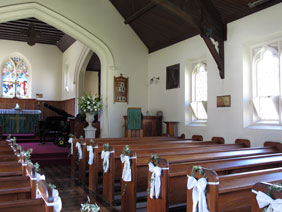Canon PowerShot G11
-
-
Written by Gordon Laing
Canon PowerShot G11 lens and stabilisation
The Canon PowerShot G11 is equipped with the same 5x optical zoom as its predecessor, delivering an equivalent range of 28-140mm and a focal ratio of f2.8-4.5; the actual focal length is 6.1-30.5mm and we counted 14 discrete steps when zooming from wide angle to telephoto. The closest focusing distance in Macro mode with the lens set to wide is just 1cm.
 |
Upon power-up the lens barrel extends by 24mm with the camera ready for action in a fraction over one second. You can see examples above of the G11 when powered down, switched on, and zoomed-in. When powered-down, the barrel retracts within the lens housing which protrudes by 8mm from the main body itself – that’s only a couple of mm beyond the G11’s grip, meaning the camera when powered down has a fairly flat front.
The G11 also employs an automatic lens covering which closes when the camera’s powered-down, so there’s no caps to worry about. To illustrate the G11’s coverage, we mounted it on a tripod and shot the same scene fully zoomed-out, then fully zoomed-in. You can see examples of this below.
|
Canon PowerShot G11 coverage | ||
 | 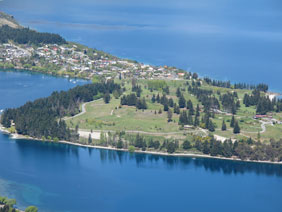 | |
6.1-30.5mm at 6.1mm (28mm equivalent) |
6.1-30.5mm at 30.5mm (140mm equivalent) | |
In use the G11’s 5x optical zoom provides a useful general-purpose range, delivering both wide-angle coverage for capturing expansive landscapes, large buildings, cramped interiors or big group shots, or zooming-into a reasonable telephoto for detail shots.
Anyone wanting longer coverage may be interested in fitting the optional TC-DC58D converter which fits onto the optional LA-DC58K accessory mount and multiplies the G11’s range by 1.4 times, effectively extending it to 196mm. These accessories do greatly increase the size of the G11 though.
It’s worth mentioning the Panasonic Lumix LX3 at this point, which may be over a year old now, but remains a key rival for the G11. At 2.5x, the LX3’s optical range is only half that of the G11, but it starts wider still at an equivalent of 24mm. This allows it to capture even larger fields of view, although with a maximum equivalent focal length of just 60mm, it won’t zoom anywhere near as close as the 140mm on the G11.
Interestingly while Panasonic does offer a teleconverter for the LX3, it won’t extend the long-end of the range, instead multiplying it by 0.75x to deliver even wider angle coverage equivalent to 18mm.
The LX3’s range may be shorter, but its lens is optically brighter with an f2.0-2.8 focal ratio. This captures twice as much light as the G11 when both cameras are zoomed-out and just over twice as much when they’re both fully zoomed-in (albeit with the G11 delivering a much tighter field of view). This brighter focal ratio allows the LX3 to use faster shutter speeds or slower sensitivities under the same lighting conditions as the G11, and is a key advantage to the Lumix.
Beyond a shorter optical range though, the other downside to the LX3’s lens is the fact it requires a separate lens cap. Not only does this add extra thickness to the lens barrel, but it also delays the time taken for the camera to be ready for action – while additionally running the risk of getting lost.
Canon PowerShot G11 image stabilisation
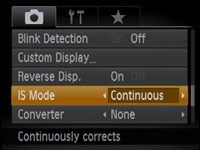 |
The PowerShot G11 employs optical Image Stabilisation to counteract camera-shake. Canon offers three modes: Continuous where the system operates all the time, Shoot Only which only applies stabilisation as you take the photo, and Panning which only stabilises in the vertical axis for when you’re moving the camera horizontally as you take the photo – for an example of using the latter, see the Blurring Action tutorial at our sister site, DSLR Tips.
To put the G11’s stabilisation to the test we photographed a distant building with the lens fully zoomed-into its maximum equivalent focal length of 140mm, first with stabilisation disabled, then with stabilised set to the default Continuous mode. Traditional photographic advice would recommend a shutter speed of 1/140 to completely eliminate camera shake without stabilisation.
Canon PowerShot G11 Image Stabilisation off / on (Continuous) | ||
 | 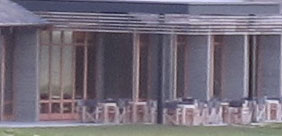 | |
100% crop, 6.1-30.5mm at 30.5mm, 1/8, 100 ISO, IS off |
100% crop, 6.1-30.5mm at 30.5mm, 1/8, 100 ISO, IS on | |
Above are 100% crops from the samples taken without, then with stabilisation at a shutter speed of 1/8 – the slowest we could reliably handhold with stabilisation. The version without stabilisation is unsurprisingly shaky, but the version with stabilisation is almost 100% shake-free. Achieving this at a shutter speed of 1/8 corresponds to four stops of compensation, which is an impressive result.
Canon PowerShot G11 focusing
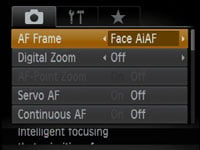 | 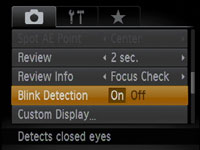 |
The PowerShot G11 offers two auto-focusing modes: Face AiAF or Flexizone. Face AiAF automatically switches the G11 between a nine-area AF system and face detection, and it’s great to have the two most common AF modes on a single option rather than having to manually select face detection on the earlier G10.
Alternatively, Flexizone allows you to manually adjust the size and position of a single AF frame. If AF-Point zoom is enabled in the menu, the G11 will also magnify the AF frame for checking with a half-press of the shutter release. In use the G11’s autofocus was accurate and fairly quick in operation, while the main Face AiAF mode never failed to switch to face detection when pointed at a human subject.
New to the G11 over its predecessor is Blink Detection, which as its name suggests, can spot when a subject has blinked at the moment the photo was captured. This works in practice, briefly displaying a blinking face icon in the corner of the screen as a warning immediately after taking the photo. It will however only work if the subject in question has already been acquired by the face detection system.
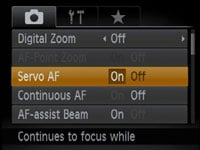 |
Like the G10 before it, the G11 also offers a Servo AF mode which can track subjects in motion. This worked in practice with subjects approaching face-on, although the camera’s disappointing continuous shooting rates (see bottom of page) make it unsuitable for capturing action sequences.
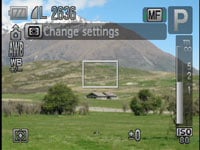 |
Pushing the rocker control upwards puts the G11 into its Manual Focus mode, after which you can use the thumb wheel to adjust the focusing distance, indicated by an on-screen scale. If MF Point Zoom is enabled in the menu, the portion in the AF frame is magnified for a closer look.
If you’d like a little extra help, the G11’s Safety MF option lets you get the focusing close by hand, then finishes it off automatically at a half-press of the shutter release or push of the focus point select button. Alternatively you can opt for the G11’s focus bracketing mode which takes three shots: one at the manually focused distance, and the others a little closer and further. The nearer and further increments can be set to small, medium and large.
Canon PowerShot G11 sensor and processing
Beyond the flip-out screen, the other major change between the G11 and its predecessor is the sensor. The earlier G10 continued Canon’s traditional policy of steadily increasing the resolution, at that time to a considerable 14.7 Megapixels. This time though, Canon’s listened to the pleas of enthusiasts, not to mention taking a leaf from its rival, the Panasonic LX3, and has reversed its usual strategy by equipping the PowerShot G10 with a 10 Megapixel sensor. This is in an attempt to deliver superior low-light performance, and Canon claims nothing less than a two-stop advantage over the G10.
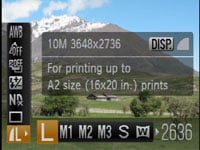 | 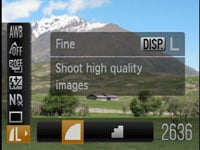 |
It certainly has the potential to be better: both the G10 and G11 share the same sized sensor, a 1/ 1.7in CCD, so by squeezing fewer pixels on the same surface, the G11 should be more sensitive.
Coincidentally, it’s the same size and resolution as the much older PowerShot G7, but Canon assured us it was a brand new sensor, allowing it to support much higher sensitivities; this ‘new’ sensor is also used in the PowerShot S90. To find out how the G11’s noise levels measure-up in practice, check out our Canon G11 High ISO Noise results page.
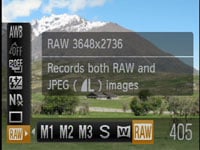 |
In the meantime, the G11 delivers 4:3 shaped images with a maximum resolution of 3648×2736 pixels. There’s the choice of four lower resolutions (6, 4 and 2 Megapixels plus a VGA mode) along with a cropped 16:9 aspect ratio, and JPEGs can be recorded in the choice of Normal or Fine compression. Sadly the Super Fine compression option of the G10 is missing here, although thankfully you still have the ability to record in RAW, with or without an accompanying Large Fine JPEG.
Fine JPEGs at the G11’s full resolution typically measure 2.5MB each, while RAW files weigh-in around 13MB each; there’s no built-in memory, so we recommend buying yourself a decent SDHC card.
RAW recording remains a key feature of the G11, and is one of only three Canon compacts to offer the facility (the others being the SX1 IS and S90). Canon supplies the G11 with its Digital Photo Professional software for processing RAW images and we have real-life examples in our results pages.
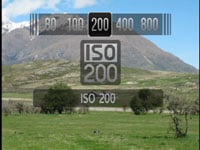 | 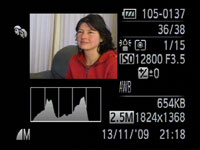 |
The sensitivity at full resolution now runs from 80 to 3200 ISO (up one stop from the G10) and is selected using the dedicated dial on top of the camera. Higher sensitivities up to 12,800 ISO are available in the Low Light mode, albeit at a greatly reduced resolution of just 2.5 Megapixels.
This image size implies pixel-binning, with groups of four pixels effectively acting as one bigger unit with up to four times the sensitivity. The Low Light mode certainly lets you shoot under very low light conditions without a flash, and you can see how it looks in the Gallery section.
There’s also an Auto ISO option, although the cunning Auto ISO Shift facility of its predecessor appears to be missing; this allowed the camera to warn you (and optionally boost the sensitivity at the press of the Direct Print button) if it thought there’d be shake at the current shutter speed.
Contrast, Sharpness, Saturation and other colour settings are applied using a variety of options in the My Colours section of the Function menu. Along with the default Off setting, the G11 offers Vivid, Neutral, Sepia, Black and White (but no filter options), Positive Film, Lighter Skin Tone, Darker Skin Tone, Vivid Blue, Vivid Green, Vivid Red and a Custom option which lets you adjust the Contrast, Sharpness, Saturation, Red, Green and Blue channels, along with Skin Tone by +/-2 steps.
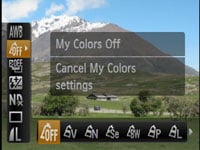 | 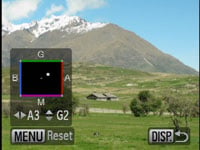 |
We used the default Off setting and found the G11 delivered natural colour and tone, along with a good balance between applying enough sharpening to reveal detail without going over the top and incurring artefacts.
It’s easy to adjust this approach if preferred using the Custom My Colours option, or better still, shoot in RAW and apply more sophisticated sharpening not to mention noise reduction later.
The Function menu also lets you adjust the White Balance between Auto, Daylight, Cloudy, Tungsten, Fluorescent, Fluorescent High, Flash, Underwater or two Custom settings; in a nice update over the earlier G10, each of the presets can now be fine-tuned, although like most non-DSLRs, there’s still no manual entry of colour temperature.
Finally, the G11 offers automatic dynamic range adjustments using its i-Contrast feature (disabled by default). i-Contrast automatically boosts shadow areas or faces darkened by strongly backlit scenes. To put it to the test we took two photos of a Church interior with and without i-Contrast set to its Auto option. This composition features dark shadow areas and strong window lighting which represents a challenge for any camera’s exposure system.
|
Canon PowerShot G11 i-Contrast (off / Auto) | ||
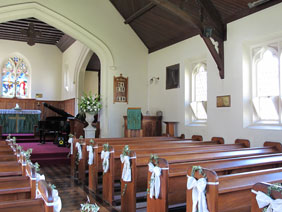 | ||
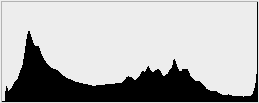 | 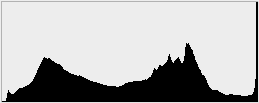 | |
i-Contrast Off: 80 ISO, f2.8, 1/3 sec |
i-Contrast Auto: 80 ISO, f2.8, 1/3 sec | |
The example above shows i-Contrast selecting the same exposure when set to its Auto mode, and while there’s no detail retrieved in the saturated windows, the darker areas such as the roof and benches have certainly received a boost. The histograms below each image give a better idea of what’s going on, with a reduction in darker shadow areas and a boost in upper mid-tones, albeit still with clipping in the highlights. Like other systems which boost shadow areas, there’s inevitably an increase in visible noise as a result, especially if you’re using anything but the lowest sensitivity.
Canon PowerShot G11 Movie mode
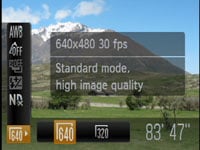 |
A year has passed since the PowerShot G10, but the new G11 shares exactly the same video recording capabilities – as such there’s still sadly no HD or even widescreen options, a disappointment considering many of Canon’s smaller and cheaper compacts offer 720p options.
We asked Canon whether this was a marketing decision to drive sales of other models in the range, but the company claims it’s a technical limitation. Either way, HD video is a major omission for a model of this calibre.
So like the PowerShot G10 before it, the G11 inherits a movie mode which can record video at either 640×480 or 320×240 pixels at 30fps. As before, the DIGIC 4 processor encodes video using the H.264 format and stores then in a QuickTime Movie wrapper.
The maximum file size for movies remains 4GB, or one hour in length, whichever occurs first; when set to 640 mode, you’ll reach the 4GB limit after around 30-40 minutes. Sadly like the G10 there’s still no optical zooming while filming, just a 4x digital boost from whatever focal length you started filming at.
The absence of HD or even optical zooming while filming makes the G11’s movie mode a disappointment in this day and age. To be fair, it looks as good as any VGA mode we’ve tested, but really a camera in the G11’s class is crying out for better video and while we applaud Canon for attempting to deliver superior low light performance, HD video should also have been on the ‘to-do’ list. After all, several Canon compacts already have it, as do most of Panasonic’s models, including many which are more than a year older than the G11.
The clip here was filmed using the best quality VGA mode – it stutters a little on this page due to the hosting at Vimeo, but the original looks fine, and registered members of Vimeo can download this file here for further evaluation. Note if you’re downloading the files from Vimeo using Internet Explorer 8, you may find the file extension is MP4 rather than the original MOV. Don’t worry, the file is otherwise identical, and you can rename the extension to MOV if necessary. As with other Canon cameras employing the same encoding system, the playback may be jerky under QuickTime for Windows; we recommend Windows users watch the files using VLC Player.
Canon PowerShot G11 Drive modes
The Canon PowerShot G11 offers one main continuous shooting option, although disappointingly it’s getting slower with every generation. Three generations ago, the G7 offered a modest 2fps with the focus locked and the screen switched off, or 0.8fps with the screen and AF switched on. The G9 followed with 1.5fps with the focus fixed or 0.7fps with AF enabled. Then the G10 fell to just 1.3fps with fixed focus, albeit the same 0.7fps with continuous AF. Now the G11, despite a drop in resolution since the G10, fires at around 1.1fps with fixed focus, and sticks with 0.7fps with AF.
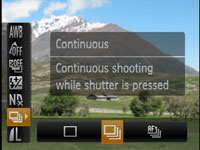 |
To put this to the test we fitted the G11 with a formatted Lexar Professional 133x 8GB SDHC card and timed its continuous shooting in various configurations. We captured 50 Large Fine JPEGs at 80 ISO in 46 seconds, corresponding to just a fraction under 1.1fps. Switching to RAW only mode though saw the G11 fire-off 20 frames in 22 seconds, corresponding to a slower rate of 0.9fps.
The JPEG rate is actually more disappointing than its already leisurely predecessor, given the reduction in resolution, but with the new model, Canon offers some consolation with its Low Light mode. Operating at a much reduced resolution of 2.5 Megapixels, the Low Light mode not only offers much higher maximum sensitivities of 12,800 ISO, but also faster continuous shooting too. We fired-off 50 JPEGs in just 21.7 seconds this time, corresponding to a rate of 2.3fps.
This is a big improvement, although still too slow to capture serious action sequences. It’s also a little disappointing when you compare it to the year-old Panasonic LX3 in this regard, which offers 2.5fps at its full resolution (for eight frames), or 6fps with a drop in resolution to 3 Megapixels. So despite the improvement on the G11, it still falls below the competition on the action stakes.
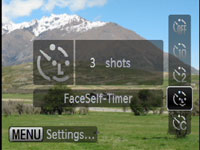 |
While continuous shooting on the G11 remains a disappointment, the camera does at least inherit the innovative self-timer options of its predecessor. Along with traditional ten and two second timers, the Custom option lets you set the countdown to as long as 30 seconds, and have the camera take one to ten shots at the end. This is handy for maximising your chance of successful poses and expressions in timed group shots.
Cleverer still is the Face Timer option, which waits until a new face enters the frame before taking the photo two seconds later; you can also change the number of shots taken from one to ten. The photographer’s traditional sprint from the camera to join a group in self-timed composition may be a thing of the past.
Now let’s see how the G11’s image quality measures-up in our Canon PowerShot G11 Real-life results pages.
